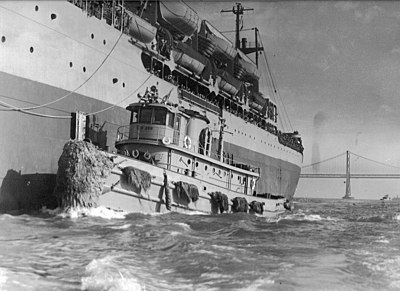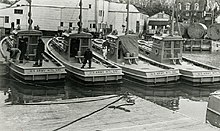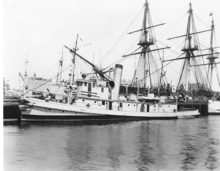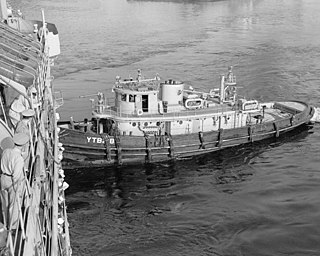
USS Achigan (YT/YTB-218) was a Cahto-class large harbor tug in the service of the United States Navy. A French-Canadian rendering of the word ashigan which, in Chippewa and Algonquian dialects, is the name of the smallmouth bass.

USS Pocahontas (YT/YTB/YTM-266), was a type V2-ME-A1 harbor tug that entered service in the United States Navy in 1943, and was sold in 1976. She was the third ship to bear the name Pocahontas.

USS Nokomis (YT-142/YTB-142/YTM-142) was a Woban-class harbor tug built in Bremerton, Wash, and assigned to Pearl Harbor, Hawaii, in 1940. Nokomis was present during the Japanese attack on Pearl Harbor, 7 December 1941. She was the first vessel on scene at the USS Arizona, and was called off by the officers on deck because of the imminent explosion of the battery below deck. It then left and helped beach the USS Nevada, with Hoga (YT-146), and YT-153. The beaching of the Nevada saved Pearl Harbor's mouth from being blocked. After that the USS Nokomis fought fires and dewatered the battleship USS California, for 3 days. This effort made the California salvageable, to be recommissioned again later in the war. Nokomis was also the last vessel to move the surviving YC-699 barge prior to the Japanese attack on Pearl Harbor. Post-war she continued serving Pearl Harbor ships until she was decommissioned in May 1973, and eventually sold for "scrap" to Crowley, in San Francisco. She was renamed Sea Serpent and served many years in the San Francisco Bay as a tug and fire boat. In 1989, after the Loma Prieta earthquake in the SF Bay area, Nokomis and Hoga fought fires alongside each other again.

USS Wenonah (YT-148/YTB-148/YTM-148) was a Woban-class district harbor tug which served during World War II in California ports, and continued her service until she was struck by the Navy in 1974. On 17 August 2009, the Wenonah sank while berthed at Treasure Island, CA, and was raised by the floating crane Left Coast Lifter on 28 August 2009.
USS Waneta (YT-384), later YTB-384, later YTM-384, was a United States Navy harbor tug in commission from 1944 to 1946 and from 1953 to 1974.
USS Evea (YT-458), originally the sixth USS Resolute (YT-458), later YTB-458, was a United States Navy tug in commission from 1943 to 1944.

USS Hiawatha (YT-265), later YTB-265, later YTM-265, was a type V2-ME-A1 harbor tug that entered service in the United States Navy in 1942, and was sold in 1987. She was the third ship to bear the name Hiawatha.
Originally contracted to be built as YT‑392 on 7 April 1941, Mecosta (YTB‑392) was laid down by Consolidated Shipbuilding Corp., Morris Heights, N.Y., 13 September 1944; launched 28 October 1944: and placed in service 20 January 1945.
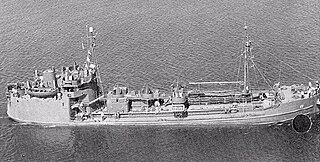
The T1 tanker or T1 are a class of sea worthy small tanker ships used to transport fuel oil before and during World War II, Korean War and Vietnam War. The T1 tanker classification is still in use today. T1 tankers are about 200 to 250 feet in length and are able to sustain a top speed of about 12 knots. The hull designation AO is used by the US Navy to denote the ship is a T1 oil tanker and AOG that the T1 is a gasoline tanker. The small size allows the T1 to enter just about any sea port or to anchor around a small island, this was very useful during the Pacific War. The T1 tanker can carry about 48,000 to 280,000 bbls. Some T1 tankers were used to transport goods other than oil, a few were used for black oil-crude oil, diesel, chemicals and rarely bulk cargo like grain. T1 tankers are also called liquid cargo carriers. The T1 tanker has about a 6,000 to 35,000 deadweight tonnage (DWT) of cargo. The small size also gives the ships short turn around time for repair, cleaning, loading and unloading. A T1 tanker carrying dirty cargo, like crude oil needs a few weeks of labor to clean before carrying clean cargo. Most T1 ships during World War II were named after major oil fields.

The Type B ship is a United States Maritime Administration (MARAD) designation for World War II barges. Barges are very low cost to build, operate and move. Barges were needed to move large bulky cargo. A tug boat, some classed as Type V ships, could move a barge, then depart and move on to the next task. That meant the barge did not have to be rushed to be unloaded or loaded. Toward the end of World War 2, some ships that had not been completed in time for the war were converted to barges. US Navy barges are given the prefix: YWN or YW. Due to shortage of steel during World War II, concrete ship constructors were given contracts to build concrete barges, with ferrocement and given the prefix YO, YOG, YOGN. Built in 1944 and 1945, some were named after elements.
Everett-Pacific Shipbuilding & Dry Dock Company was established in 1942 to build ships needed for World War II. Yard construction began on 1 March 1942. As part of the Emergency Shipbuilding Program, the US Navy provided some of the capital to start Everett-Pacific Shipbuilding at Port Gardner Bay in Everett, Washington. Everett-Pacific was sold in 1945 to the Pacific Car and Foundry, who was already a major manufacturer of railcars and trucks. Pacific Car and Foundry was building barges for the US Navy during World War II at plants in Renton, Seattle and Tacoma in the state of Washington. The lease for the shipyard in Everett, Washington ended in 1949 and the yard closed. Pacific Car and Foundry in 1972 changed its name to Paccar Inc. to reflect its major products. The Everett-Pacific shipyard site later became part of Western Gear, a heavy machinery manufacturer. From 1987 to 1992, the shipyard was rebuilt to become part of Naval Station Everett. Everett-Pacific Shipbuilding was started by William Pigott Jr. a Seattle businessmen and his brother Paul Pigott (1900-1961). William Pigott Jr. was born in 26 Aug. 1895 in Pueblo, CO and died on 8 July 1947 in San Francisco, CA.
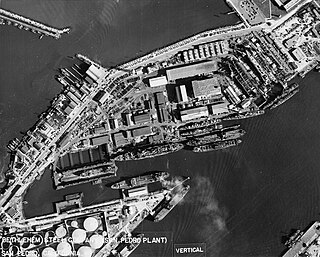
Bethlehem Shipbuilding San Pedro was a major shipbuilding company on Terminal Island in San Pedro, California owned by Bethlehem Shipbuilding Corporation. To support the World War 2 demand for ships Bethlehem Shipbuilding San Pedro built: US Navy Destroyers and after the war tugboats. The yard became involved in World War II production in the early shipbuilding expansions initiated by the Two-Ocean Navy Act of July 1940. At its peak during the war about 6,000 worked at the yard, Bethlehem Shipbuilding San Pedro shipyard was opened in 1918 as Southwestern Shipbuilding by Western Pipe & Steel. Western Pipe & Steel sold the shipyard to Bethlehem Shipbuilding Corporation in 1925. Shipbuilding ended after World War 2 in 1946. In 1983 the shipyard was sold to Southwest Marine. In 1997 Southwest Marine operated four shipyards, which they sold to The Carlyle Group. Carlyle Group renamed the shipyard US Marine Repair. In 2002 US Marine Repair sold all six of its yards to United Defense Industries. In 2005 it was sold to BAE Systems but the yard was not used and the yard is now part of the Port of Los Angeles. The shipyard was located at 1047 South Seaside Ave, San Pedro.

W. F. Stone & Son or Stone Boat Yard was a small wooden shipbuilding company in Alameda, California. To support the World War 2 demand for ships W. F. Stone & Son built tugboats, sub chasers and minesweepers. For World War 1 the shipyard, then called W. F. Stone & Son at Kennedy and Bocimer Streets, built tugboats for postwar work in 1921. The shipyard was opened in 1853 by William F. Stone, from Dartmouth, England, at the Hunter's Point in San Francisco Bay, near the current Hunters Point Naval Shipyard. In 1892 William Stone's son, Frank, ran the company and moved the shipyard to Tiburon. In 1899 he moved the shipyard again to Harbor View, San Francisco. In 1911, he again moved to Diesel Way, in Oakland, near Union Point Park on the Tidal Canal. When Lester Stone, Frank's son, became a partner, the company was changed to W. F. Stone & Son. In 1923, Frank Stone died, Lester Stone continued the company. In 1942 the company moved again, to 2517 Blanding Ave, Alameda on the south side of the Tidal Canal. In 1970 Lester Stone retired and sold the shipyard to John Whitset. Whitset, who did not rename the company, the company went into bankruptcy in 1986. It came out of bankruptcy and was sold to Bill and Grace Bodle. Bodle sold the company in 2000 to David Olson. The shipyard closed in 2004. For most of its history, the shipyard built a large variety of schooners, fishing boats, cargo ships, tugboats, sailboats, racing and recreational yachts.

Anderson & Cristofani was a wooden shipbuilding company in San Francisco, California. To support the World War 2 demand for ships Anderson & Cristofani shipyard switched over to military construction and built: US Navy APC coastal transports, tugboats, Patrol Boats and Minesweepers.

The Pacific Coast Engineering Company or PACECO Corp. is an American industrial fabricator and mechanical engineering company headquartered in Haywood, California. It is a wholly-owned subsidiary of Mitsui E&S.

Eureka Shipbuilding was a wooden shipbuilding company in Eureka, California. The shipyard was just south of town in Fields Landing on the South Bay of Humboldt Bay. To support the World War 2 demand for ships Eureka Shipbuilding shipyard switched over to military construction and built: United States Marine Corps tugboatss. Eureka Shipbuilding was started in 1941. On January 25, 1943 Eureka Ship Builders, Inc. was awarded a contract to build six V2-M-AL1 tugboats at a cost of $35,970 each, contact number DA-MCc-824. V2-M-AL1 tus is a class of Type V ship. The V2-M-AL1 is also called a Port Sewall class tug. V2-V2-M-AL1 tugs were named for American ports. All of Eureka Shipbuilding tug were used for Lend-Lease use to Britain as type TUSA tugs. After the war in 1947 the company was renamed `

Splinter fleet or Splinter navy was a nickname given to the United States wooden boats used in World War II. The boats served in many different roles during the war. These boats were built in small boatyards on the West coast and East coast, Great Lakes and the Gulf of Mexico. They could be built quickly, in just 60 to 120 days. Most of the boats were built by boatyards that already had the tools and knowledge from building yachts, sailboats and motor boats. Many were built by craftsmen in family-owned small businesses. Under the Emergency Shipbuilding Program and War Shipping Administration contracts went out to over fifty boatyards across the country. The boats were built for the US Navy, the United States Army Air Forces, United States Coast Guard, and US Army. Some of the wooden boats went to Allied nations on the Lend-Lease program.
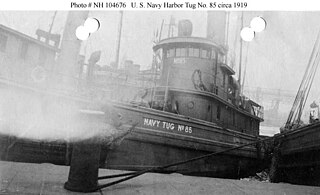
The YT-46-class harbor tugboat was a wood-hulled tugboat design ordered by the U.S. Navy in May and June 1918 during World War I. 40 ships of the type were launched and completed at 13 shipyards: the Charleston Navy Yard; the New Orleans Naval Yard; the Clayton Ship & Boat Building Company, Clayton, New York; the Eastern Shipyard Company, Greenport, New York; the Eastern Shore Shipbuilding Company, Sharpstown, Maryland; the Greenport Basin and Construction Company, Greenport, New York; the Hiltebrant Dry Dock Company, Kingston, New York; Robert Jacob Shipyard, City Island, New York; the Luders Marine Construction Company, Stamford, Connecticut; the Mathis Yacht Building Company, Camden, New Jersey; the New York Yacht, Launch & Engine Company, Bronx, New York; the Vinyard Shipbuilding Company, Milford, Delaware; and the Wheeler Shipyard Corporation, Brooklyn, New York. In 1920, at the Navy's adoption of alpha-numeric hull designations, the ships were classified as yard tugs YT-46 though YT-85.
The YT-86-class harbor tugboat was a wood-hulled tugboat design ordered by the U.S. Navy during World War I. 15 ships of the type were launched and completed, 12 as harbor tugs and three as ambulance boats. All were launched at the Mare Island Naval Shipyard in Vallejo, California except for one at the Pearl Harbor Naval Shipyard in Hawaii. In 1920, after the Navy's adoption of alpha-numeric hull designations, the ships were classified as yard tugs YT-86 though YT-90 and YT-92 through YT-99 and ambulance boats YH-1, YH-2, and YH-3.
